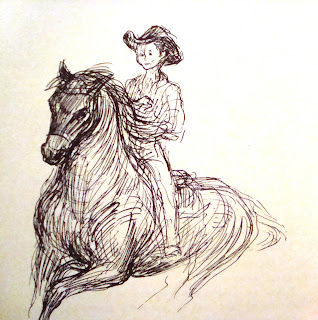Pagan The
Black
Dorothy
Potter Benedict, il. John Groth
1960,
Pantheon Books
"Tomorrow's the day," Dad said.
"Tomorrow we'll break Pagan."
Those
were the words Sandy Seaton had been waiting to hear. Ever since he was nine
and the wild black colt had been run onto the open range to grow up alone and
Dad had said "Yes, tyke, he will be yours -- someday." Now, this
Friday night, with school closed for the summer, Pagan three and he twelve, he
heard the words he'd longed for and, instead of whooping and hollering, he sat
still and silent at the table.
Sandy's
silent worry is that Slim, his beloved mentor and his father's rough but
dependable ranch hand, will push the temperamental young horse as he pushed the
horse's dam, three years earlier, causing her death. It's not a baseless fear.
The first chapter of this book uses an extensive flashback to establish the
backstory of 12-year-old Sandy and his black stallion Pagan. Six years earlier,
the Seaton family moved West from Washington, D.C., after Sandy's soldier
father was injured in battle. Shortly thereafter, a stranger finds their ranch
during a blizzard, bringing an orphaned filly inside the ranch house with him.
The stranger is Slim Erickson, who becomes Mr. Seaton's right-hand man on the
ranch. The filly is Siren, and she becomes the love of young Sandy's life. But
after two happy years, his attempt to break her to saddle end in a savage bite and
in Siren being exiled to winter on the range. When they bring her in the next
summer, she has a colt.
"She wasn't spendin' her winter reformin',"
Slim said.
When they
try to separate mare and half-grown foal, the young Pagan shows signs of his
dam's temper, and Siren herself has a fatal encounter with barbed wire. From
then on, it's a struggle between Sandy and Slim over whether Pagan is safe.
Their argument seems to resolve after a successful race at the local rodeo, but
reappears when Pagan attacks a man.
Also in
the mix, rather suddenly, is the family's adoption of a lost girl, Mistie,
whose floozy mother dies in a bar fall caused by her latest boyfriend, a
villain who holds a grudge against the Seatons stemming from an incident at the
rodeo. Mistie, sulky and traumatized, begins to heal with the help of a mare,
Sunrise, lent by a neighbor. More adventures follow, including Slim saving
Sandy's life, Mistie confronting her past, and Pagan on trial for his life.
I feel like
I've come across the akward Sandy/Slim scenario in other horse books. For some
reason, the author is reluctant to put father and son in true opposition, so
they put in a hired hand, an experienced man with horses but one who lacks
sensitivity or education, who's plenty stubborn and loudly opinionated, but
often wrong.
The Mistie
plot seems to belong to another book. The implication is fairly clear that her
mother's all but a prostitute, and Mistie's being groomed for a similar fate.
It's similar in tone to the hard-edged breaking scenes, but the content is
disturbing for a children's book.
Of course, a
boy and a great black stallion starred in another 20th century children's book.
Here, as in Farley's series, the boy is at first conscious of not being
entirely in control of the situation when he's riding his horse. But as he and
Pagan learn, he gains control. As Slim growls,
"A
critter ain't a machine... You got to ride him every minute an' I mean
ride."
About the
Author
Dorothy
Potter married Charles Calvert Benedict (West Point, 1915) They had three
children - Charles Calvert Benedict, Jr., Patricia and Calvert P. Charles was a
West Point grad who served in WWI and died on active duty in a flight accident
at Langley Field, VA in 1925. Both sons went into the military and both
followed their father into West Point; Charles Jr. followed his father into
West Point and died over Manchuria when a Japanese plane made a kamikaze attack
on his bomber in 1944. Calvert served for 35 years, including a stint as
commandant of the U.S. Army command in West Berlin. Patricia married another
career soldier, Col. Harrison Lobdell, Jr., also from a military family; four
of her grandsons went to West Point, and two served in Iraq. Dorothy
apparently never remarried, dying December 4, 1979. She was buried at Cold
Spring Cemetary, Cold Spring, New York.
This was a
challenging project, and I never did really find out too much about Mrs.
Benedict. She would have been born at the end of the 19th or the start of the
20th centuries, and anyone born that long ago is much harder to research
online. The only reason I found this much was the military connection. It
reminded me of researching a Mormon author, where you find out a slew of facts
but they're all related to only one aspect of a person's life. It was certainly
an interesting military background, but I was unable to dig up anything related
to the most salient point from the perspective of this blog - the Potter
family's ranch in Montana.
Books
Pagan The Black il. John Groth (1960)
Fabulous il. Joseph
Papin (1961)
Bandoleer il. Joseph
Papin (1963)
Other
writing
Consort: A
Comedy in Three Acts (1934)
One
Virginity by pseud. Benny Dick (1938)
Let's Not
Drown The Symphony - essay in The Christian Herald?
"Tough
Guy Belisarius" by Dorothy Potter
Benedict in Ladies Home Journal








No comments:
Post a Comment